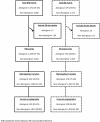Transfers to metropolitan hospitals and coronary angiography for rural Aboriginal and non-Aboriginal patients with acute ischaemic heart disease in Western Australia
- PMID: 24886321
- PMCID: PMC4021447
- DOI: 10.1186/1471-2261-14-58
Transfers to metropolitan hospitals and coronary angiography for rural Aboriginal and non-Aboriginal patients with acute ischaemic heart disease in Western Australia
Abstract
Background: Aboriginal people have a disproportionately higher incidence rate of ischaemic heart disease (IHD) than non-Aboriginal people. The findings on Aboriginal disparity in receiving coronary artery procedures are inconclusive. We describe the profile and transfers of IHD patients admitted to rural hospitals as emergency admissions and investigate determinants of transfers and coronary angiography.
Methods: Person-linked hospital and mortality records were used to identify 28-day survivors of IHD events commencing at rural hospitals in Western Australia. Outcome measures were receipt of coronary angiography, transfer to a metropolitan hospital, and coronary angiography if transferred to a metropolitan hospital.
Results: Compared to non-Aboriginal patients, Aboriginal patients with IHD were more likely to be younger, have more co-morbidities, reside remotely, but less likely to have private insurance. After adjusting for demographic characteristics, Aboriginal people with MI were less likely to be transferred to a metropolitan hospital, and if transferred were less likely to receive coronary angiography. These disparities were not significant after adjusting for comorbidities and private insurance. In the full multivariate model age, comorbidities and private insurance were adversely associated with transfer to a metropolitan hospital and coronary angiography.
Conclusion: Disparity in receiving coronary angiography following emergency admission for IHD to rural hospitals is mediated through the lower likelihood of being transferred to metropolitan hospitals where this procedure is performed. The likelihood of a transfer is increased if the patient has private insurance, however, rural Aboriginal people have a lower rate of private insurance than their non-Aboriginal counterparts. Health practitioners and policy makers can continue to claim that they treat Aboriginal and non-Aboriginal people alike based upon clinical indications, as private insurance is acting as a filter to reduce rural residents accessing interventional cardiology. If health practitioners and policy makers are truly committed to reducing health disparities, they must reflect upon the broader systems in which disparity is perpetuated and work towards a systems improvement.
Figures
Similar articles
-
Disparities experienced by Aboriginal compared to non-Aboriginal metropolitan Western Australians in receiving coronary angiography following acute ischaemic heart disease: the impact of age and comorbidities.Int J Equity Health. 2014 Oct 21;13(1):93. doi: 10.1186/s12939-014-0093-3. Int J Equity Health. 2014. PMID: 25331586 Free PMC article.
-
Voting with their feet--predictors of discharge against medical advice in Aboriginal and non-Aboriginal ischaemic heart disease inpatients in Western Australia: an analytic study using data linkage.BMC Health Serv Res. 2013 Aug 20;13:330. doi: 10.1186/1472-6963-13-330. BMC Health Serv Res. 2013. PMID: 23962275 Free PMC article.
-
Disparities in revascularization rates after acute myocardial infarction between aboriginal and non-aboriginal people in Australia.Circulation. 2013 Feb 19;127(7):811-9. doi: 10.1161/CIRCULATIONAHA.112.000566. Epub 2013 Jan 14. Circulation. 2013. PMID: 23319820
-
An Overview of Indigenous Australian Disadvantage in Terms of Ischaemic Heart Disease.Heart Lung Circ. 2018 Nov;27(11):1274-1284. doi: 10.1016/j.hlc.2018.03.003. Epub 2018 Mar 12. Heart Lung Circ. 2018. PMID: 29929920 Review.
-
A Systematic Review of Services to DHH Children in Rural and Remote Regions.J Deaf Stud Deaf Educ. 2018 Apr 1;23(2):118-130. doi: 10.1093/deafed/enx059. J Deaf Stud Deaf Educ. 2018. PMID: 29514244
Cited by
-
Disparities experienced by Aboriginal compared to non-Aboriginal metropolitan Western Australians in receiving coronary angiography following acute ischaemic heart disease: the impact of age and comorbidities.Int J Equity Health. 2014 Oct 21;13(1):93. doi: 10.1186/s12939-014-0093-3. Int J Equity Health. 2014. PMID: 25331586 Free PMC article.
-
Knowledge translation lessons from an audit of Aboriginal Australians with acute coronary syndrome presenting to a regional hospital.SAGE Open Med. 2016 Jul 28;4:2050312116661114. doi: 10.1177/2050312116661114. eCollection 2016. SAGE Open Med. 2016. PMID: 27516880 Free PMC article.
-
In-hospital outcomes by insurance type among patients undergoing percutaneous coronary interventions for acute myocardial infarction in New South Wales public hospitals.Int J Equity Health. 2023 Oct 23;22(1):226. doi: 10.1186/s12939-023-02030-1. Int J Equity Health. 2023. PMID: 37872627 Free PMC article.
-
Risk of Major Adverse Cardiovascular Event Following Incident Hospitalization for Acute Gout: A Western Australian Population-Level Linked Data Study.ACR Open Rheumatol. 2023 Jun;5(6):298-304. doi: 10.1002/acr2.11540. Epub 2023 May 11. ACR Open Rheumatol. 2023. PMID: 37170735 Free PMC article.
-
Exploring the effects of transfers and readmissions on trends in population counts of hospital admissions for coronary heart disease: a Western Australian data linkage study.BMJ Open. 2017 Nov 17;7(11):e019226. doi: 10.1136/bmjopen-2017-019226. BMJ Open. 2017. PMID: 29151055 Free PMC article.
References
-
- Australian Institute of Health and Welfare. Australia’s health 2012. Australia’s health series no.13. Canberra: Australian Institute of Health and Welfare; 2012.
-
- Australian Institute of Health and Welfare. Cardiovascular disease: Australian facts 2011. Canberra: Australian Institute of Health and Welfare; 2011.
-
- Katzenellenbogen JM, Sanfilippo FM, Hobbs MS, Briffa TG, Ridout SC, Knuiman MW, Dimer L, Taylor KP, Thompson PL, Thompson SC. Incidence of and case fatality following acute myocardial infarction in Aboriginal and non-Aboriginal Western Australians (2000–2004): a linked data study. Heart Lung Circ. 2010;19(12):717–725. doi: 10.1016/j.hlc.2010.08.009. - DOI - PubMed
-
- Katzenellenbogen JM, Sanfilippo FM, Hobbs MS, Briffa TG, Ridout SC, Knuiman MW, Dimer L, Taylor KP, Thompson PL, Thompson SC. Aboriginal to non-Aboriginal differentials in 2-year outcomes following non-fatal first-ever acute MI persist after adjustment for comorbidity. Eur J Prev Cardiol. 2012;19(5):983–990. doi: 10.1177/1741826711417925. - DOI - PubMed
-
- Katzenellenbogen JM, Sanfilippo FM, Hobbs MST, Briffa TG, Knuiman MW, Dimer L, Thompson PL, Thompson SC. Complex impact of remoteness on the incidence of myocardial infarction in Aboriginal and non-Aboriginal people in Western Australia. Aust J Rural Health. 2012;20(6):305–311. doi: 10.1111/j.1440-1584.2012.01314.x. - DOI - PubMed
Publication types
MeSH terms
LinkOut - more resources
Full Text Sources
Other Literature Sources
Medical


